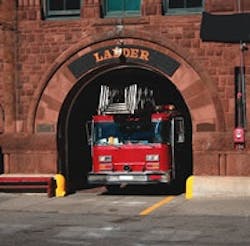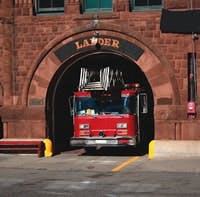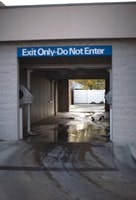What Gas-Fired Infrared Heating Has to Offer
When you think about the heat in your building, your first consideration may be of the forced-air variety—the big unit suspended from the ceiling that blows hot air with the force of a jet engine. While that might work for some applications, independent reports reveal that gas-fired infrared heating can save anywhere from 20 to 50 percent in fuel consumption over forced-air heating.
Two Types of Infrared Heating
There are two types of infrared heating: high intensity and low intensity. High-intensity heaters have been around since the 1950s. These types of heaters require high mounting heights due to an open flame that covers a ceramic surface. High-intensity heaters also have a reflector to help direct the heat where it needs to go. These are used to spot-heat areas with few workers and are typically unvented.
Low-intensity gas-fired infrared heating systems emulate the true efficiency of the sun by generating radiant heat energy. They consist of three main components: a burner control box, black-coated radiant emitter tubes, and a highly polished reflector assembly. The heaters are typically suspended from the ceiling by chains and are controlled by a thermostat. They can be installed either vented or unvented; they may use outside air for combustion, if necessary; and they may be installed in different configurations, depending on the heating requirements.
Low-intensity heaters also have an enclosed flame. When heat is required, the burner control box ignites a gas/air mixture; hot gas is pushed through steel radiant tubing by an internal fan. As this gas passes through the assembly, the tubing is heated and emits infrared energy, which is then directed toward the floor by highly polished reflectors. This energy is absorbed by objects in its path (the floor, machinery, and people). Objects in the path of the infrared energy re-radiate this heat to create a comfort zone at the floor level. This method of heating - as opposed to filling a room with warm air - allows the source of heat to begin at the floor level and not the ceiling.
With a forced-air system, heat escapes as doors are opened. When the doors close, the system has to reheat the air as if from a cold start-up; however, with infrared heat, the floor acts as a reservoir. When doors are opened, the slab loses very little of its heat; when the doors close, this mass acts as a huge heat sink to warm surrounding air. This creates the most efficient and effective heating method for the diverse conditions present in most commercial and industrial applications.
The Positives of Infrared Heating
Infrared heaters offer several operational and design benefits that aren't achievable with conventional heating units:
-
They can save up to 50 percent on fuel savings vs. forced-air units.
-
They don't blow dust and debris around like heaters that rely on blowers for heat distribution, which makes for a cleaner, quieter environment.
-
Their zoned capability allows a group of units to function together or independently.
-
They're capable of mounting heights of up to 60 feet, depending on which heater is chosen for the application.
-
They can spot-heat certain areas that don't contain many workers.
-
They're directional and capable of being installed along a sidewall; the reflectors can be rotated to direct heat where it's most needed.
-
They can use outside air for combustion.
-
Low-intensity heaters can be vented together to reduce the number of roof or wall penetrations.
-
Their design is flexible. Heater placement can be in the middle of the shop or even in a U- or L-shaped configuration around a workstation, where heat is most needed.
The Negatives of Infrared Heating
There are a few important things to consider when using this type of radiant heat. While these systems are easy to live and work with, when laying out the system, care needs to be taken to maintain clearance to combustibles. Infrared radiant heaters require higher clearances than forced-air units; therefore, a mounting height of 10 feet or taller is recommended, depending on the application and the model.
Very little maintenance is required for these systems, especially when outside air is brought in for combustion (this is recommended when dust or contamination is present inside the building). Periodic dusting of the reflectors is beneficial not only for safety, but also for the overall efficiency of the heater. This is easily done by vacuuming the surfaces of the unit occasionally or by blowing them off with an air-compressor hose.
Safety Considerations
Mentioned above, a critical safety factor to consider before installing an infrared heating system is clearance to combustibles. Clearance to combustibles is defined as the minimum distance that must be maintained between the radiant tube heater surface and the combustible item. Considerations must also be made for moving objects that are near the infrared heater and materials that have lower temperature ratings, such as plastics. Shielding of these items might be necessary. Examples of combustibles include lights, overhead doors, gas and electrical lines, parked vehicles, cranes, and any other obstructions or hazards.
It's important to provide warnings to alert tenants/occupants of potential hazards and safety actions. Signs must be posted to specify maximum stacking heights to maintain clearance to combustibles, especially in storage areas.
Unless otherwise indicated, infrared heaters are not certified for use where flammable gases or vapors are present, such as in spray booths.
In addition, observing recommended mounting heights will optimize comfort conditions in the space. If infrared heaters are mounted too high or too low, it may result in a lack of heat or discomfort; however, certain applications, such as freeze protection, outdoor patio heating, or spot heating, might require that the heaters be mounted at a height other than the traditional recommended mounting heights.
New Technology
An advanced feature of low-intensity infrared tube heaters is the use of two-stage controls. A two-stage infrared heater is characterized by its ability to operate in preset high- and low-fire modes. Since infrared heating systems are typically designed around worst-case scenarios, a single-stage system becomes oversized on milder days, creating more on/off cycles. With two-stage technology, input (fuel usage) is reduced by 35 percent (100-percent input in high-fire mode and 65-percent input in low-fire mode). Field reports, as well as studies performed by RDM Engineering in Ontario, have proven a minimum fuel savings of 12 percent and a reduction of on/off cycles by up to 30 percent with the majority of heater operation occurring in low-fire mode. A two-stage heater allows for application design flexibility based upon the possible worst-case changes in the environment.
In addition to fuel savings, reduced on/off cycles, and design flexibility, additional benefits of two-stage heaters include faster heat recovery, higher downstream tube temperatures, longer flame, and longer equipment life. More importantly, a two-stage heater will provide a softer, more comfortable heat source for occupants when compared to a single-stage heater, which is either operating at full output (sometimes too much heat) or cycles off (not enough heat).
The Price of Staying Warm
If your organization is one to count pennies, you might want to stick with the forced-air method. But, if you can live with a small investment, infrared heating might be a wise choice. Gas-line connections must be considered, and hanging the unit is at least a two-person job. The initial cost of a standard unitary tube heater of 40 feet in length will run you approximately $1,100. Upfront costs are higher than traditional heating methods; however, this investment will pay for itself in a short period of time due to the energy-saving benefits of infrared heaters. Interested in even more fuel savings? Installing a system that incorporates two-stage technology can offer an additional 12 percent in fuel savings over a standard single-stage infrared heater.
Distribution of Infrared-Heating Systems
Although installation may be fairly easy, system design and layout can be more difficult. It's critical that the equipment is installed properly to assure a safe, effective heating system.
Most manufacturers sell product via local representatives. This allows a professional to review your needs and select the proper equipment for your specific application. A local representative may also provide guidance in suggesting a contractor who is familiar with the installation of infrared heating systems.
Infrared-Heating Applications
Some applications that make good use of infrared heating systems:
-
Fire stations.
-
Aircraft hangars.
-
Wood shops or pole barns.
-
Car washes.
-
Auto shops.
-
Restaurants.
-
Agricultural buildings.
-
Driving ranges.
-
Warehouses.
-
Manufacturing buildings.
Michelle Fox is product support assistant at Warren, MI-based Detroit Radiant Products Co..




